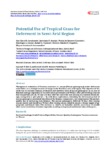Use este identificador para citar ou linkar para este item:
http://www.alice.cnptia.embrapa.br/alice/handle/doc/992255Registro completo de metadados
| Campo DC | Valor | Idioma |
|---|---|---|
| dc.contributor.author | CAVALCANTE, A. C. R. | pt_BR |
| dc.contributor.author | ARAÚJO, J. F. | pt_BR |
| dc.contributor.author | CARNEIRO, M. do S. | pt_BR |
| dc.contributor.author | SOUZA, H. A. de | pt_BR |
| dc.contributor.author | TONUCCI, R. G. | pt_BR |
| dc.contributor.author | ROGERIO, M. C. P. | pt_BR |
| dc.contributor.author | VASCONCELOS, E. C. G. | pt_BR |
| dc.date.accessioned | 2014-08-13T06:41:27Z | - |
| dc.date.available | 2014-08-13T06:41:27Z | - |
| dc.date.created | 2014-08-12 | pt_BR |
| dc.date.issued | 2014 | pt_BR |
| dc.identifier.citation | American Journal of Plant Sciences, v. 5, p. 907-914, 2014. | pt_BR |
| dc.identifier.uri | http://www.alice.cnptia.embrapa.br/alice/handle/doc/992255 | pt_BR |
| dc.description | Abstract: Management evaluation of Panicum maximum cv. massai (Massai guineagrass) under deferment contributes as a strategic reserve of forage in the Brazilian semi-arid region. The objective of this study was to evaluate biomass production and nutritive value of massai guineagrass in an area of thinned caatinga vegetation in two deferment periods (60 and 90 days after plot-leveling cut) and four use periods (30, 60, 90 and 120 days after the end of the rain season), in a random blocks design arranged in a split-plot (2 × 4), with three replications. Extending the deferment period of massai guineagrass promoted elevation of the biomass components, but compromised the pasture quality due to increasing stem biomass. The massai guineagrass deferred 30 days after raining season started and should use 90 days after raining season ended to ensure a forage supply of appropriate nutritional value. The increase in relative air humidity and the occurrence of rainfall after water restriction stimulate regrowth, resulting in improved nutritional value of the grass. | pt_BR |
| dc.language.iso | eng | eng |
| dc.rights | openAccess | eng |
| dc.subject | Guineagrass Massai guineagrass | pt_BR |
| dc.subject | Enriched Caatinga | pt_BR |
| dc.subject | Nutritional value | pt_BR |
| dc.title | Potential use of tropical grass for deferment in semi-arid region. | pt_BR |
| dc.type | Artigo de periódico | pt_BR |
| dc.date.updated | 2014-08-13T06:41:27Z | pt_BR |
| dc.subject.thesagro | Panicum maximum | pt_BR |
| dc.subject.thesagro | Proteína bruta | pt_BR |
| dc.subject.thesagro | Biomassa | pt_BR |
| dc.subject.thesagro | Valor nutritivo | pt_BR |
| dc.subject.thesagro | Digestibilidade | pt_BR |
| dc.subject.thesagro | Nutrição vegetal | pt_BR |
| dc.subject.thesagro | Planta forrageira | pt_BR |
| dc.subject.thesagro | Caatinga | pt_BR |
| dc.subject.nalthesaurus | Crude protein | pt_BR |
| dc.subject.nalthesaurus | Digestibility | pt_BR |
| dc.subject.nalthesaurus | Pastures | pt_BR |
| dc.subject.nalthesaurus | Plant nutrition | pt_BR |
| dc.subject.nalthesaurus | Biomass | pt_BR |
| riaa.ainfo.id | 992255 | pt_BR |
| riaa.ainfo.lastupdate | 2014-08-12 | pt_BR |
| dc.identifier.doi | 10.4236/ajps.2014.57103. | pt_BR |
| dc.contributor.institution | ANA CLARA RODRIGUES CAVALCANTE, CNPC; Jucivânia F. Araújo, Animal Science Department, Federal University of Ceará (UFC) - Fortaleza, CE, Brazil; Maria do Socorro Carneiro, UFC - Fortaleza, CE, Brazil; HENRIQUE ANTUNES DE SOUZA, CNPC; RAFAEL GONCALVES TONUCCI, CNPC; MARCOS CLAUDIO PINHEIRO ROGERIO, CNPC; Elayne Cristina G. Vasconcelos, UFC - Fortaleza, CE, Brazil. | pt_BR |
| Aparece nas coleções: | Artigo em periódico indexado (CNPC)  | |
Arquivos associados a este item:
| Arquivo | Descrição | Tamanho | Formato | |
|---|---|---|---|---|
| apPotential.pdf | 1,19 MB | Adobe PDF |  Visualizar/Abrir |









